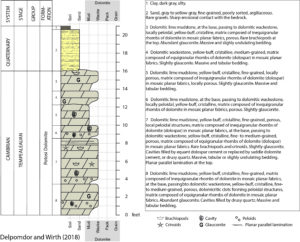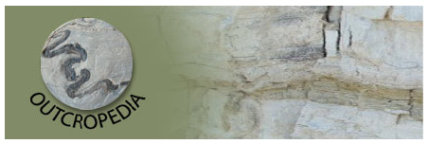Stratigraphy: The Potosi Dolomite outcrops in an abandoned quarry near the NE corner of Sec. 23, T22N, R11E (US State Plane Coordinate System). The exposure is about 145 m (470 ft) long and up to 5 m (16 ft) high. The yellow to buff-weathering dolomite is semi-crystalline, fine-to medium-grained, glauconitic, and contains rare oboloid brachiopods….


Stratigraphy: The Potosi Dolomite outcrops in an abandoned quarry near the NE corner of Sec. 23, T22N, R11E (US State Plane Coordinate System). The exposure is about 145 m (470 ft) long and up to 5 m (16 ft) high. The yellow to buff-weathering dolomite is semi-crystalline, fine-to medium-grained, glauconitic, and contains rare oboloid brachiopods. Texturally, the rock is dolomitic lime mudstone to dolomitic wackestone. Beds range from 0.6 to 1.8 m (2 to 6 ft) thick and are tabular to slightly undulating. Beddings vary between N00 09E and N69E 10SE. Glauconite grains are greenish and range from 1 to 3 mm (1/30 to 1/10 inches) in diameter. Cavities, filled by an equant or saddle dolomite cement or drusy quartz, are common and regionally are characteristic of the Potosi Dolomite.
Paleontology: Fossils in the Cambrian Potosi Dolomite are sparse. Algal domes (Cryptozoon), rare trilobites (Saukiella), Hypseloconus (high-conical monoplacophoran mollusks), and gastropods have been reported from the Potosi Dolomite by Buschbach (1975).
Geochronology: The Potosi Dolomite lies entirely within the Saukia Zone, including Rosettia and Saukiella-Calvinella Subzones at the base and the top, respectively (Howe et al., 1972) and is correlated with the first appearance datum of the Lotagnostus americanus, index fossil of Stage 10 of the Furongian Series (Upper Cambrian). These faunal relations support the assignment of the Franconia Formation (unit above the Potosi Dolomite) and Potosi Dolomite to the Franconian-Trempealeauan Stages of the Croixan Series in North America and the global Jiangshanian Stage and Stage 10 of the Upper Cambrian Series.
Deposition: The carbonate rocks of the Potosi Dolomite records a transgressive sequence (4th-order), which included mid ramp (bioclastic dolomitic wackestone) to offshore-onshore inner ramp (dolomitic, laminated, bioclastic lime mudstone and wackestone, and medium-to coarse-grained sandy dolomite) facies.
References:
Buschbach, T.C., 1975, Cambrian System in Willman H.B., et al. (editors) Handbook of Illinois Stratigraphy: Illinois State Geological Survey Bulletin, v. 95, p. 34-46.
Delpomdor, F.R.A., and H. Wirth, 2018, Bedrock geology of Chana Quadrangle, Lee and Ogle Counties, Illinois: Illinois State Geological Survey, USGS-STATEMAP contract report, 2 sheets, 1:24,000.
Howe, W.B., V.E. Kurtz, and K.H. Anderson, 1972, Correlation of Cambrian strata of the Ozark and upper Mississippi Valley regions: Missouri Geological Survey, Report of Investigations 52, 60 p.
Tel Rick Kennay, N41.888996/W89.255243
Indirizzo
E Gurler Rd, Ashton 2393 61006 Chana
